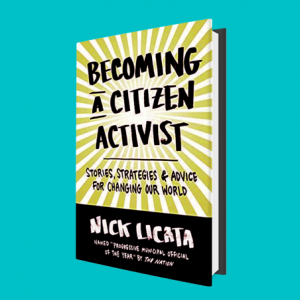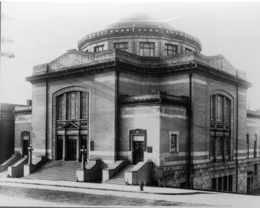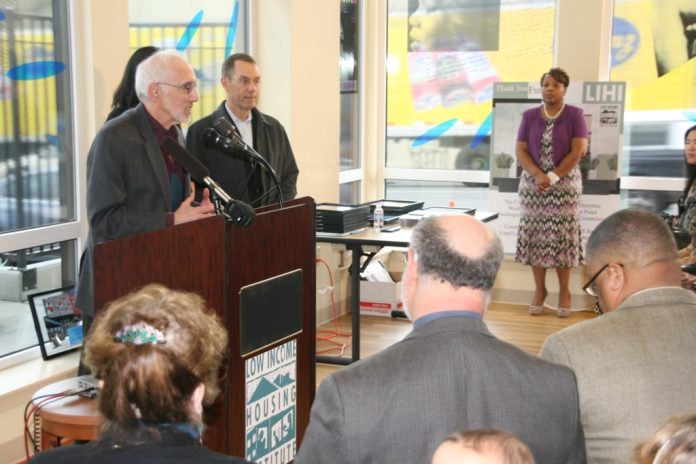Former Seattle city council member, Nick Licata is holding a salon on Design and Citizen Activism on August 8th with UW Professor Karen Cheng. Licata, who served five terms on the city council, has published a book called Becoming a Citizen Activist. I met up with him at Café Racer to discuss his views on activism and the debates over multi-family zoning, the Center City Connector, the Showbox, and more.
What prompted you to hold this upcoming salon on Citizen Activism and Design?
It wasn’t my idea. Arcade approached me. I’m the special editor for their fall edition focusing on how two communities are responding to the impact of Seattle’s tremendous growth and economic development. One community is Magnuson Park, which has a large number of folks who are living in affordable housing, and the other is the Central Area. Arcade was interested in whether Seattle has an ethos and, if so, how is that ethos manifested in the changes we see going on.
Kelly Rodriguez, who heads up Arcade, asked me and Karen Cheng to be the speakers for the salon to see how we would tie in activism and design, which I had never thought about before.
Can you tell more about your book, Becoming a Citizen Activist? What was its backstory?
While I was on my last term at the city council, I was very interested in reflecting on what it is that makes some people be more politically active than other people. Why was that I was always prone to want to be an activist?
I had been working on this book [on the rise and fall of the student power movement] for about five years. I hadn’t really thought about writing anything else, but then I thought, how about a handbook for activists? The publisher at Sasquatch said, ‘I like that title. Why don’t you write that? Why not use the work you got and throw in the work on the city council? Weave the different experiences together?’

The title was something we wrestled with. I wanted it to be “becoming” rather then “become” because I wanted to give a sense of the process one goes through. And citizen, I got push back, like well you know this isn’t just for citizens, it’s for people who live here. I said that’s the definition of citizen. We all live here. We are citizens of a democracy. And the last is activism or being an activist, which I sort of shied away from because I sort of don’t like people to go around calling themselves activists. But I redefined that to mean the potential that each of us has to take some political power and control over our lives. That’s why at the end of the book I say we have to believe in democracy because if we believe in that then we have the ability to affect change. You can activate your life. You can be part of the decisions that are being made.
Do you have any recommendations for how people who care about issues in Seattle can join decision-making processes?
The first step is figure out what it is that you are really interested in. The second is that you should educate yourself. You need to know who is involved in that issue. Everything from homelessness to gun control, what is it in those realms you are interested in? What is it that moves you? And then, what are the organizations that are involved? Read and Google that particular issue in your town and figure out who is doing something about it… you have to understand who the players are both as individuals and owners of the issue, and then also what are the top priorities currently being struggled over.
Once you’ve made that sort of groundwork, you need to ask yourself, how much capacity do I have and how much do I want to devote to this? Do I have an hour a day or five hours a week? You have draw parameters around your involvement. That’s important.
So you’re knowledgeable about who’s involved, you know what particular items you are interested in, and you know what kind of commitment you can make, then you can directly jump right into trying to influence public officials, which is fine. But you might also decide there is someone else there who is influencing those public officials, you may decide to see what they are doing too.
Your book refers to the importance of seeing the small things that generate big things. What is something small you would recommend citizens pay attention to in Seattle?
Imagine you’re walking around the streets. Ask yourself, it’s hot, it’s sunny– what’s the thing that you are looking for? You’re looking for shade. For foliage. One of the major problems we have in the city of Seattle, unlike Portland, which has done a better job, is that we are not only not protecting the trees we have, but we are not replacing them at a rate that allows the city to have better air quality, and creates a cooler city– not in a cultural sense, exactly — but in terms of reducing the temperature by having more shade… We have start measuring foliage. And we have to start thinking about how we protect and expand our foliage.
In regards to zoning battles in Seattle, do you have any advice about we may find some unifying factors around this issue and move forward with increasing housing in the city?
The first question is are you providing enough housing for people who work in your city? One of things that we should be talking about in Seattle is at least a measurement of how much affordable housing is needed for jobs being created.
If we can get agreement on what the [housing to jobs] ratio should be that really frames the debate, so then you can work toward innovative solutions. Don’t begin with a discussion of “Should we upzone all of Seattle?” It would be like throwing a match into a gasoline tank. You are not going to a non-emotional discussion about that topic from either side. The best way to get some systemic progressive changes occurring is to begin with a rational approach and strip away the hot buttons. See if you can get in agreement on what the problem is and what the framework for that problem is. Then you can have the debates. Without a boxing ring, a boxing match is basically just a brawl.
How would you recommend citizens advocate for bigger projects that may not yield results quickly but serve a long-term purpose, like the Center City Connector?
The CCC, in particular, could be framed that way, but I don’t think it works out so well for the CCC as a long-range objective. However, I do think I was too critical of light rail and Sound Transit. My criticisms when they first started were on accountability and fiscal matters. I always left the door open.
One of the arguments is that people like fixed rail because its reliable and people understand where to use it and where it goes, it has a logical point a and point b and bus systems don’t have that, so I believe that there is a role for fixed rail. But I think we have to look at is who the rail serves and what the payback period is. With fixed light rail, the payback period is not going to be five years, it may not even be ten years, but at twenty years.
Back to the CCC, the problem is that I don’t think the payback is going to work even for that length of time. If you look at the advocates for CCC, they are not transit advocates, they are downtown business interests. (Editor’s note: Present company excluded. We think it’s very much about transit and Downtown Seattle real estate will be highly valuable either way.) That’s fine. It will help retail activity on the line. And it will help to a certain extent people moving around who work downtown or shop downtown. But it doesn’t deal with the larger problem–and this is where priorities come in–of how to get people into the city.
Whether you are an advocate or not for a particular issue, it comes to knowing your stuff, knowing your data, and being able to present an argument for why it’s going to pan out, according to a cost benefit analysis and over what period of time.
In your book you wrote, “Victory breeds optimism. It’s generally preferable to go for a likely victory than chancing likely defeat.” Are there any likely victories that you see that citizens could seize in Seattle?
There are easy victories and hard victories. If you are choosing what is an easy victory, one of things you have to think about is that victory is not one hundred percent. Victory may in fact involve multiple steps of incremental change. I think for instance, on bike sharing is an easy victory we have had, even though we had some defeat early on with Pronto. But we learned a lesson about what works. Now there are more people riding bikes, using a different model. That model still will need to be adjusted.
Are there any hard victories?
The hard victories something that I have given some thought to. One of them is saving the Showbox. 78,000 signatures have been collected already from people who want to save the Showbox. So without a doubt the Showbox is an icon for a large sector of the population.

The problem is that the developer would have to commit to funding affordable housing. They won’t have to include it in the project, but they have to put money toward affordable housing, which is good. What people tend to forget, though, is that the company is not doing that out of the generosity of their heart. They are doing it because we passed a law that was heavily debated requiring it.
If the city can require developers to make affordable housing available where they hadn’t in the past, it seems that we also have the ability to determine what are we sacrificing in that process. Our cultural heritage is what really has sold Seattle to many people outside of Seattle and made us a growing and prosperous city. The challenge is can we save the Showbox and not just the edifice, but its actual function. But still not sacrifice the contribution to homeless housing. I think there is a way. One of the ways that I think needs to be investigated is what happened with regards to the First United Methodist Church on Fifth Avenue, where developer Kevin Daniels was nudged by Dow Constantine to carve out that church from his development.

You may sacrifice some building stories. You may sacrifice some ground floor. But in exchange you preserve part of Seattle’s heritage. Now in order to make that work, you need creative leadership; it isn’t enough to have people on the council who vote the right way. Because you can vote the right way all the time and lose all the time. The challenge is to get five votes and to do it through creative solution making where no one is seen as the enemy or the loser.
I believe Kshama Savant is involved in trying to rally folks on the city council and Lisa Herbold is trying to work out something on the Kevin Daniel’s model. I think some of the other council members may be looking at other options as well.
In addition to signing the petition, is there anything else citizens can do to express support for the Showbox or other issues they care about?
They can show up at city hall or send old-fashioned letters, even email. Online petitions are fine, but you need to follow through. Physical presence helps a lot.
Your book was published in 2016. Is there anything that you would like to add, sitting here in 2018?
On my website, I published two handbooks. One is the Becoming a Citizen Activist Handbook. It’s something short and simple that people can get their hands on. The other handbook is for politicians. It’s about what they have to keep in mind to work with citizens.
People ask me all the time if I’m going to write another book. What I want is to see this book help folks to gain political control over their lives.
Note: This interview has been edited for brevity and clarity.
Mayor Durkan Refuses to Meet with Coalition Backing Center City Streetcar
Natalie Bicknell Argerious (she/her) is a reporter and podcast host at The Urbanist. She previously served as managing editor. A passionate urban explorer since childhood, she loves learning how to make cities more inclusive, vibrant, and environmentally resilient. You can often find her wandering around Seattle's Central District and Capitol Hill with her dogs and cat. Email her at natalie [at] theurbanist [dot] org.


